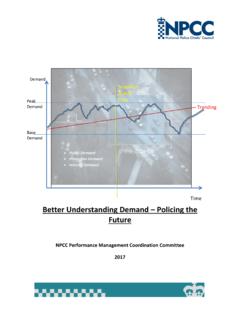Transcription of Digital Forensic Science Strategy
1 July 2020 Digital ForensicScience Strategy3 Digital Forensic Science Strategy July 2020 Use and disclosure of data contained on this page is proprietary and Forensic Science Strategy July 2020 Use and disclosure of data contained on this page is proprietary and Improving commercial practices and R&D ..27 Industry ..27 Coordinating requirementsStrategic engagement to develop capabilities Research and development ..30 Benefits ..31 Strategic benefitsTactical benefits3. Meeting the data challenge ..35 Infrastructure requirements ..36 Processing, analysing and sharing Digital Forensic data ..37 Benefits ..40 Strategic benefitsTactical benefits4. Developing the Workforce.
2 43 Developing a joint approachCollaborative governanceBuilding a skills pipelineStandard approaches for training and competencyEffective workforce planningContinuing professional development and learningKnowledge managementBuilding multidisciplinary collaborationAddressing the needs of the wider workforce CSIs, first responders, frontline data recovery users and investigatorsBenefits ..48 Strategic benefitsTactical benefits5. Building Trust ..51 Public attitudes towards Digital forensics ..51 Ethical governance and oversight ..52 Improving governance and data security ..53 Operational guidanceDataQuality standardsCommunicating public benefitBenefits ..57 Strategic benefitsTactical benefitsPutting it all.
3 59 Supporting research ..60 policing data captureOriginal researchRapid evidence reviewsProof of conceptsSimulation modellingGlossary of Terms ..61 ContentsForeword ..4 Executive challenges ..6 Core challenge 1: VolumeCore challenge 2: ComplexityCore challenge 3: LegitimacyIssue 1: Lack of support servicesIssue 2: Fragile commercial marketplace Issue 3: Limited strategic engagement with partners (academia and industry) to work on long term solutions Issue 4: Recruitment and retentionIssue 5: Lack of DF Science awareness within policingIssue 6: Embedding qualityIssue 7: Handling legacy dataThe solution ..8 Improved operationsImproved commercial practicesCentralising Science and Research and Development (R&D)Meeting the data challengeDeveloping the workforceBuilding trustIn conclusion.
4 11 Introduction ..12 Our starting point ..12 New possibilities in a changing landscape ..12 Here and now ..13 Meeting the challenges ..13 Core challenge 1: VolumeCore challenge 2: ComplexityCore challenge 3: LegitimacyIssue 1: Lack of support servicesIssue 2: Fragile commercial marketplace Issue 3: Limited strategic engagement with partners (academia and industry) to work on long term solutions Issue 4: Recruitment and retentionIssue 5: Lack of DF Science awareness within policingIssue 6: Embedding qualityIssue 7: Handling of legacy dataStrategic objectives ..161. Improving operations ..19 The role the Forensic Capability Network plays ..20 Core principles of future operations.
5 21 Benefits ..24 Strategic benefits:Tactical benefits:5 Digital Forensic Science Strategy July 2020 Use and disclosure of data contained on this page is proprietary and Forensic Science Strategy July 2020 Use and disclosure of data contained on this page is proprietary and summaryDigital Forensic (DF) Science - examining Digital evidence to support investigations and prosecutions - was once niche but is now very much mainstream. Over 90% of all crime is recognised as having a Digital element, and society s accelerating use of technology means the critical role DF Science plays will only grow. We have developed this Strategy to address the huge opportunities and corresponding challenges this presents for NPCC commissioned and owns this Digital Forensic Science Strategy .
6 It builds on and supports the National policing Digital Strategy (NPDS). We draw on parallels with that Strategy , how they relate to DF Science , identify challenges unique to providing DF capabilities and lay out how we will address them. This Strategy supports the aims and objectives of the policing vision , Digital Forensic Units (DFUs) delivered DF services. But DF Science is expanding outside DFUs and Forensic labs and frontline staff now do some Digital Forensic work too. So this Strategy considers the needs of DF Science across the criminal justice system, from crime scene to courtroom. We look at DF Science as the golden thread running through the investigative process, including specialist analysis by practitioners in DFUs as well as more straightforward extraction of data by trained users outside Strategy recognises the exciting potential of emerging technologies for policing .
7 Investigative capability can be transformed with the rapid and unique insights from DF analysis of any of our myriad devices, which can replace months of physical surveillance, giving unprecedented access to our thoughts through conversations or search histories; though if policing is to use this ability, it must do so responsibly, sensitive to the ethical issues that arise. At the same time, DF services can take advantage of rapidly growing cloud services, allowing us to simplify and rationalise DF data storage, harness the power of automation, and explore new technologies such as machine learning. To allow policing to unlock the enormous potential of technology, forces need to coordinate effectively and work together to overcome the challenges this will Forensic Science sits at the heart of delivering justice in the 21st century, spanning the entire criminal justice system, from crime scene to courtroom.
8 It shapes policy, offers a range of capabilities that better enable us to counter new and emerging threats, and is central to achieving our shared outcomes around reducing crime and increasing public safety. To date however, we haven t been quick enough or co-ordinated enough in making use of the potential that Digital forensics offer, to find a way to take advantage of the huge advances in mobile, cloud, artificial intelligence, sensors and analytics that are commonplace in almost ever y other walk of life. While crime and criminals have become ever more digitally sophisticated, our response, at ever y level of law enforcement, has been slow, fractured and piecemeal.
9 To create a justice system that truly meets the needs of the public in the Digital age, while also meeting demands for greater efficiency, we must think differently about our approach to ever y element of Digital and Digital forensics in we are to deliver against our ultimate priorities to protect children from sexual exploitation, to break the scourge of County Lines, to disrupt terrorism and reduce serious violence and do so in a way that is proportionate and ethical, we need a coherent, cohesive, and collective response to the use of Digital forensics. This Strategy lays out a way for us to meet these challenges head on. In the course of developing this Strategy , we have carried out research and analysis to understand, at a granular level, the that will enable us to respond quickly, effectively and collectively to threats in the future, whatever those threats may be.
10 The lion s share of work to develop this Strategy was complete before the COVID 19 pandemic hit this countr y. Since then the circumstances in which we find ourselves have changed problems we face. While the problems themselves are familiar growth in demand, rapid pace of technological change and policing s struggle to adapt our research has served to highlight the scale and urgency of the issues and underline the pressure our service is under. A number of these challenges are addressed in the recent NPCC and APCC National policing Digital Strategy1, which elegantly articulates how Digital transformation, improvements in the use of data and technology, and a huge skills uplift are central to meet 2030 ambitions.











